48! That’s right...four dozen!!!
That’s the record-breaking number of humpback whale babies that I’ve ID-ed and catalogued since getting back from Tonga several weeks ago.
To put that into some context...that's 2x the number of babies we counted in 2010.
Moreover, our previous record was 31 mother/ calf pairs (in 2009), meaning that we blew past the high tally two seasons ago by 17! Or to look at it another way, this year’s count trounced the previous high by a factor of more than 1.5x!
In case it’s not entirely obvious, I’m really excited. Like, giddy-little-kid-who-scarfed-down-too-much-halloween-candy excited.
First, because having so many baby whales is obviously terrific news for the ongoing recovery of the southern hemisphere humpback whale population. And second, because it’s vindication.
Back in the day, when I first started visiting Vava’u, the generally accepted wisdom was that there were perhaps a half dozen babies, maybe a few more, that were seen in the area each season. Within short order, I started to believe that there were more. Many more.
In fact, back in 2004, I went out on the proverbial limb (where I have tendency to find myself) and said there might be 40 or more babies in a season.
It’s taken a number of years, but this season’s calf count finally proves that 40 to 50 baby humpback whales in the Vava’u area is not only do-able, but is almost certainly an underestimate in some seasons.
Although I’ve photo-identified 48 mother/ calf pairs, there were many more whales that I either didn’t see, or did see but wasn’t able to ID. In fact, I have a number of photos of mother/ calf pairs that I think are additional ones. The thing is...I can’t be 100% sure, so I haven’t included them. Bummer, but all-in-all, it’s better to be conservative than to incorporate questionable data.

Summary of humpback whale calf sightings in Tonga during the 2011 season
One thing that I want to make clear...even though I've put in the time to organise, sort through and compile the data, there are actually a lot of people involved in this effort.
To name but a few: The many people who joined me in Tonga (62 people this season, hundreds more in the past!), who in effect, funded the time to undertake this project; Friends who've contributed photos and IDs this season, like Shawn, Douglas, Allan and Ma'ata; Friends like Mark and Karen, who sent me valuable information to help piece together theories about false killer whale attacks and escort relationships; The boat captains and crews (Endangered Encounters, Whale Watch Vava'u), whose dedication to keeping us safe and happy was invaluable; and Takaji and Emiko, who've been working with me on this project since we started.
In other words, this project is a group effort, involving dozens of people from all around the world. Thank you very much!!!
Given the high number of whales, the full summary is big. It’s a 64-page PDF file and about 196MB. To make this information as accessible as possible, I’ve prepared two different files available for download. The first is the 15-page summary, which is an overview of the key points but does not contain any of the photo-ID sheets. It is a 3.4MB file.
The second is the full 64-page document, which contains the 15-page summary plus photo-ID sheets for every ID-ed calf. It is 196MB.
Right click on the relevant link below to download the files.
Humpback Whale Calf Encounters in Tonga 2011 - Summary Only (v1, 31 October 2011)
Humpback Whale Calf Encounters in Tonga 2011 - Full File (v1, 31 October 2011)
Humpback Whale Calf Encounters in Tonga 2011 - Full File (v2, 01 November 2011, updated 201142 Faua to show split dorsal fin. Thanks to Robert Pierce for pointing out the split fin!)
In addition, I’ve uploaded all the location data for our calf sightings to two Google Maps. The first is this one, which shows the locations of all of our encounters with humpback whale mother/ calf pairs that I was able to ID:
View 2011 Humpback Whale Calf IDs Tonga in a larger map
The flags represent GPS data; the blue dots are hand-marked locations. I encourage you to click through to the full map, as there are notes for each of the encounters, and it's much easier to view the information on the full map.
The second is a map that shows the locations of mother/ calf pairs that we encountered, but were unable to establish IDs for. The red pins are mother/ calf pairs I wasn't able to ID; the green pins are mother/ calf pairs initially marked as unknowns, but later assigned IDs after reviewing photographs. Again, if you click through to the full map, there are notes for each of the sightings.
View 2011 Unidentified Humpback Whale Calf IDs Tonga in a larger map
Finally, in case you have a bad connection and can’t download either file, I’m appending the text of the summary to the end of this post. I can't, however, include the four summary tables, which set out all the encounters and timelines. The only way to view those is to download one of the two files.
One request: If you have photographs and sighting information for humpback whale mother/ calf pairs from this season that are not in my summary file, please let me know. It would be just so awesome to cross the 50-calf mark!
I will post updated versions of my calf count file as and when additional data comes in.
Here's the introductory text of my humpback calf count summary for the 2011 season in Vava’u, Kingdom of Tonga:
Introduction
This document is a summary of humpback whale calf encounters in and around the Vava’u island group in the Kingdom of Tonga during the months of August to October 2011.
During our stay this year (05 August to 01 October), we identified 45 humpback whale mother/ calf pairs over the course of 73 in-water encounters, with three additional IDs contributed by friends, for a total of 48 humpback whale mother/ calf pairs.
We initially recorded 33 sightings of calfs that we were unable to identify at the time of encounter. We were later able to assign IDs to two of those 33 in the process of preparing this summary, lowering the total unknown calf sightings to 31.
This is the highest number of mother/ calf pairs we have identified and tabulated since commencing this annual calf count project in 2008.
This season was notable in other respects as well:
- There were reliable reports of whales arriving in the Vava’u area by mid-June, with calf sightings reported before the end of June. This is several weeks earlier than the timing in a hypothetical average season, and contrasts with the relatively late arrival of the whales in 2010. The whales did not, however, seem to leave the area any earlier than normal.
- Overall whale behaviour/ disposition was “neutral”, meaning significantly less standoffish than in 2010, but not as approachable as in “friendly” seasons like 2009.
- We documented three returning mothers. The mother of 201132 Toluua was also the mother of 200913 Luna, easily recognisable by her unique dorsal fin. Of note, her relaxed disposition was the same as it was two years ago, and both juveniles were friendly and inquisitive. The mother of 201107 Fitu was the same as the mother of 200920 Mama’s Boy. And the mother of 201115 Tahanima was the same as the mother of 200814 Jet.
- We documented three mother/ calf pairs travelling between Vava’u and Toku Island, about 40km away. Travel among islands is not unusual, but it is the first time we have documented this taking place with photographs and GPS data.
- For the first time, we recorded data pertaining to escort relationships with mother/ calf pairs. Over half of all mother/ calf pair encounters involved at least one escort, which seems to be a relatively high ratio viz. other humpback whale breeding and calving grounds.
- We documented two long-term associations between an escort and mother/ calf pair: At least 14 days for 201114 Tahafa and at least 18 days for 201142 Faua. This is the first time we have observed/ noticed this. Such long-term associations seem to be unusual, or perhaps not well documented.
- Of interest, in both cases of long-term escort association, the mother/ calf pairs undertook the 40km journey between Vava’u and Toku while in the company of their respective long-term escorts.
- We also documented three occasions when escorts with mother/ calf pairs were singing, or vocalising in a song-like manner: 201114 Tahafa, 201121 Uataha and 201130 Tolunoa. We have come across this behaviour on multiple occasions in previous seasons as well.
- There were two juveniles with all-white pectoral fins, the first we’ve seen in the Vava’u area. They were 201127 Uafitu and 201142 Faua.
- We documented several juvenile whales with injuries that suggest coordinated attack by a pod of marine mammals, possibly false killer whales (Pseudorca crassidens).
Overall, there was an abundance of whales this season, a lot of interesting social interaction, and many opportunities to observe and record humpback whale behaviour. This document focuses upon the mother/ calf pairs and associated whales. For additional background information, please refer to the following blog posts:
Swimming with Humpback Whales in Tonga | 2011 Season Part 1
Swimming with Humpback Whales in Tonga | 2011 Season Part 2
Swimming with Humpback Whales in Tonga | 2011 Season Part 3
Swimming with Humpback Whales in Tonga | 2011 Season Part 4
Swimming with Humpback Whales in Tonga | 2011 Season Part 5
Swimming with Humpback Whales in Tonga | 2011 Season Part 6
Swimming with Humpback Whales in Tonga | 2011 Season Part 7
Swimming with Humpback Whales in Tonga | 2011 Season Part 8
All of this work has been and is being done on our own time, with our own resources. We are not receiving financial or other assistance, and we are not affiliated with any person or organisation involved with cetaceans.
If you have photographs of humpback whale mother/ calf pairs from the 2011 season in Vava’u that are not included in this file, or additional information about whales already included in this document, please contact Tony Wu.
Reference documents:
2008 Calf Summary, 2009 Calf Summary, 2010 Calf Summary
Methodology
- Our basic methodology has remained unchanged since commencing this calf count project, with our core ID team comprising Tony Wu, Takaji Ochi, and Emiko Miyazaki.
- We recorded GPS locations for all sightings of humpback whale calfs upon initial visual and/ or radio confirmation. We used Garmin GPS 60 and GPS 72H handheld units for marking GPS locations and converted to Google KML format using HoudahGPS. When GPS units were not available, we marked locations by hand on a map.
- Where possible, we entered the water to photograph mother/ calf pairs and other associated whales if any.
- We made notes of behaviour, easily recognisable physical traits, and any other noteworthy circumstances.
- For the first time, we have recorded the number of escorts with each mother/ calf pair sighting, for the purpose of tracking escort activity from this season onward.
- When we were able to take photographs of sufficient quality and quantity to establish an ID, we named and assigned a numerical ID to the relevant calf.
- In those cases where we were unable to get sufficient photographs to establish ID, we did not name the calfs. We recorded the sightings as unknowns and cross-checked any photos of such juveniles with subsequent ID-ed whales to look for possible matches.
- We have uploaded all the GPS and hand-marked location data to Google Maps, where the locations of all ID-ed calfs and unidentified calfs are available for viewing. GPS locations are also embedded as hyperlinks throughout this document when there is text that refers to date and location of sightings. Clicking the hyperlinks will take you to Google Maps to view the relevant location.
- The photographs contained in this document represent a small portion of the images we collected. For most ID-ed calfs, we have many more images for verification purposes.
Observations
- Figure 1 below illustrates our cumulative calf counts over the past four seasons (incorporating all ID-ed juvenile whales each season, including those contributed by third parties). While we recognise that there are inherent differences in each season (different periods of stay, varying number of boat days, weather variations, etc.), the slope of the line representing cumulative calf count has appeared relatively similar across previous seasons. With the addition of data for 2011 however, a divergence in the slopes of the curves for 2009 and 2011 from those for 2008 and 2010 is apparent. This makes intuitive sense against the backdrop of the number of calf encounters, overall whale mood and other conditions in each season.
- During our stay this season, we had 73 encounters with 45 mother/ calf pairs that we identified over 76 boat-days on the water (compared with 22 calf IDs over 81 boat days in 2010; 26 calf IDs over 59 boat days in 2009; 16 calf IDs over 67 boat days in 2008; 14 calf IDs over 53 boat days in 2007). This worked out to 0.59 Calf/ Boat-day, with a boat-day being defined as a single day of approximately six hours on the water on a boat looking for whales. These figures do not include calf IDs contributed by other people.
- As is apparent from Figure 2, this season was exceptional, with the Calf/ Boat-day ratio significantly exceeding the levels recorded in each of the previous seasons. In our 2010 summary, we posited that a Calf/ Boat-day ratio of 0.25 might represent the norm, with 2009 being an outlier. With this season’s ratio of 0.59 however, the question of whether there is a normal level or not becomes more intriguing.
- It is certainly possible that our experience in 2011 is exceptional, and that we will not see a similarly high number and density of humpback whale mother/ calf pairs in the Vava’u area in the future. However, given the 0.44 ratio recorded in 2009, and our personal recollections of similarly high numbers and frequency of mother/ calf pair encounters in 2004 and 2005, it seems possible that there is no “norm”, and that the Calf/ Boat-day figure may vary unpredictably within a relatively broad band.
- What this underscores is that extrapolating from limited observation in any single season to draw conclusions about the dynamics of the southern hemisphere humpback whale population is inadvisable. Only long-term observation and consistent recording of data may eventually reveal underlying patterns and trends.
- In addition to the calf IDs we established, we received three more mother/ calf pair IDs from friends (201115 Tahanima from Shawn; 201143 Fatolu from Douglas, 201148 Favalu from Allan/ Ma’ata), bringing the total ID-ed calf count to 48.
- In 2009, we commenced recording sightings of unknown mother/ calf pairs (those whales which we are unable to ID at the time), by marking GPS location, taking notes about behaviour, and taking photos when possible, for the purpose of trying to establish IDs at a later point. This year, we recorded 33 unknown mother/ calf pairs. We were later able to establish IDs for two of those 33 (Unknown calf #10 = 201146 Faono; Unknown calf #27 = 201147 Fafitu), meaning that we ended up with 31 unidentified calfs (compared with 16 in 2010; 24 in 2009).
- Figure 3 depicts the total Calf Sighting Ratio for 2009 to 2011, where we have defined Calf Sighting Ratio as = (Total ID-ed calf count + Total unidentified calf count)/ Total boat-days. This ratio was 1.01, which compares with 0.49 for 2010 and 0.85 for 2009. This ratio provides a reasonable indication of the overall level of humpback whale mother/ calf pair activity in the Vava’u area.
- We again found mother/ calf pairs throughout the entire topography of the Vava’u Island group without apparent clustering or preference for a specific area. As with 2010, however, there were not many sightings in North Bay, once again consistent with our experience from most previous seasons. 2009 was the exception, when we recorded a significant number of encounters in North Bay. We recorded more encounters in the Toku area than in previous seasons. This may, however, have been due to the fact that calm conditions prevailed for a number of days in the latter part of the season, allowing several visits to Toku. See map of ID-ed mother/ calf pairs and map of encounters with unidentified whales.
- The pattern of sightings once again supports our notion that, for the most part, humpback whale mother/ calf pairs use Vava’u as a transit area, visiting for a short duration before moving on, returning to the area at a later date in some instances. Within this context however, we have documented a number of repeat sightings over extended periods of time:
- 201103 Tolu (4 encounters/ 30 days);
- 201114 Tahafa (9 encounters/ 33 days, Vava’u to Toku to Vava’u);
- 201120 Uanoa (3 encounters/ 27 days);
- 201123 Uatolu (2 encounters/ 29 days, Toku to Vava’u);
- 201130 Tolunoa (2 encounters/ 33 days); and
- 201142 Faua (2 encounters/ 18 days, Toku to Vava’u).
- 201005 Ikumi (11 encounters/ 31 days);
- 201008 Lele (3 encounters/ 11 days);
- 200904 Stitches (4 encounters/ 23 days); and
- 200912 Luna (3 encounters/ 13 days).
- Of note is that in three of the long-term sightings for 2011, the relevant mother/ calf pairs were sighted in both Vava’u and Toku. This is the first time we have documented travel by mother/ calf pairs between the two locations, which are about 40km apart.
- As was the case in 2009 and 2010, the ratio of female to male juveniles favoured females. This year, we counted 13 females and 10 males. In 2010, it was 7 female to 4 male. In 2009, it was 14 female to 9 male. Given that this relationship has remained in favour of females for three consecutive seasons, it’s tempting to speculate that females may represent a greater proportion of overall calf births than males. Since it is not possible to establish the sex of every juvenile encountered, we cannot be certain of this however, and need to consider other possible explanations as well. It could be the case, for instance, that mother/ calf pairs with female babies tend to be more favourably disposed to interacting with people.
- We documented long-term escort relationships with two of the mother/ calf pairs sighted over an extended period of time. In the case of 201114 Tahafa, the same escort stayed with the mother/ calf pair from at least 01 September to 14 September (14 days). In the case of 201142 Faua, the same escort remained with mother and calf from at least 20 September to 07 October (18 days). To the best of our knowledge, such long-term escort + mother/ calf relationships have not been documented previously in this area.
- Spurred in part by observation of these long-term escort + mother/ calf relationships, we commenced recording escort sightings this season. In several instances, we were able to observe the effects of escorts on mother/ calf behaviour. In some cases, the adult females appeared to dislike the attention of the males; in other cases, the presence of an escort seemed to have a calming effect. We have made notes of such behaviour in the individual ID pages that follow.
- Out of 48 ID-ed mother/ calf pairs, 30 were accompanied by escorts in at least one encounter with the relevant mother/ calf pair, a ratio of 0.63. Out of 76 total encounters with those 48 ID-ed mother/ calf pairs, 40 encounters involved at least one escort, a ratio of 0.53. In the case of unidentified mother/ calf pairs, the ratio was 0.35. We only calculated one ratio for unidentified mother/ calf pairs because we had only one encounter with each pair. In any event, the proportion of mother/ calf pairs accompanied by escorts was high. Subjectively, this is consistent with our experience in previous seasons.
- We documented three repeat mothers this season, making a total of five females that we’ve documented returning to the Vava’u area with second babies since 2008.
- The mother of 201132 Toluua was the same as the mother of 200913 Luna. Her unique dorsal fin made it easy to recognise her, and her overall friendly disposition in both 2009 and 2011 made it relatively easy to photograph her and the calf. Of note, both Toluua and Luna were inquisitive and pro-active in their approach to people in the water.
- The mother of 201107 Fitu was the same as the mother of 200920 Mama’s Boy.
- The mother of 201115 Tahanima was the same as the mother of 200814 Jet.
- We documented several juvenile whales with injuries that suggest coordinated attack by a pod of marine mammals, possibly false killer whales (Pseudorca crassidens). Refer to summary pages for 201107 Fitu, 201114 Tahafa, 201120 Uanoa, and 201144 Fafa to see the wounds. See also this blog post for a discussion of this topic.
- We documented two juveniles with all-white pectoral fins: 201127 Uafitu and 201142 Faua. This is interesting because these are the first such calfs we have seen in the Vava’u area. In previous seasons, we had wondered where the adults with all-white pectoral fins come from, as we had not seen any juveniles with this trait.
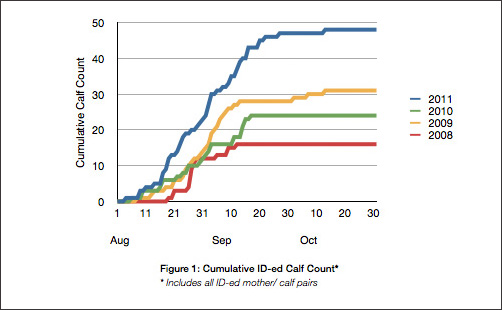
Cumulative count of humpback whale calf IDs in Tonga
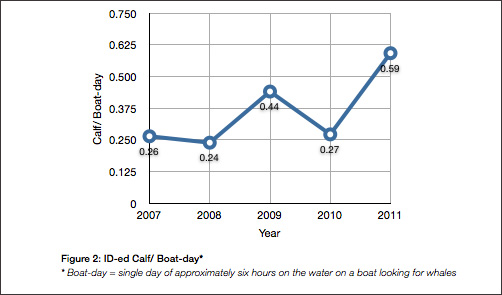
Humpback whale calf IDs per boat day in Tonga
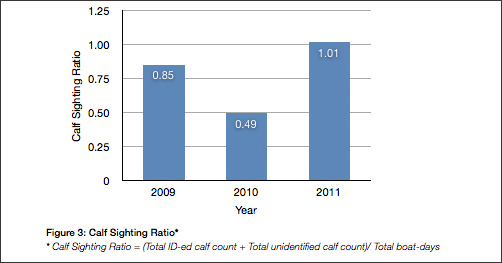
Calf Sighting Ratio for 2011 Humpback Whale Season in Tonga
This adds to our long-term repeat sightings in previous seasons:
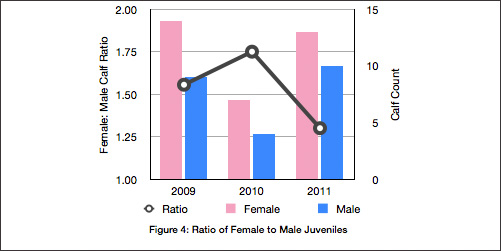
Ratio of female to male humpback whale calfs in Tonga
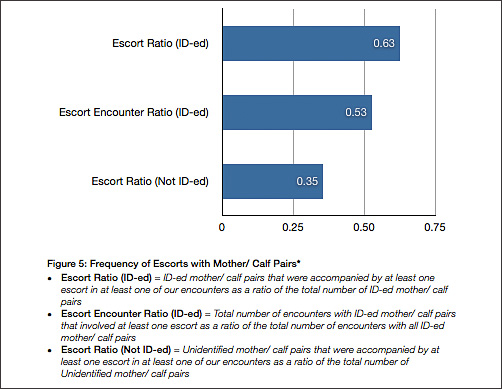
Frequency of escort whales accompanying mother/ calf pairs in Tonga
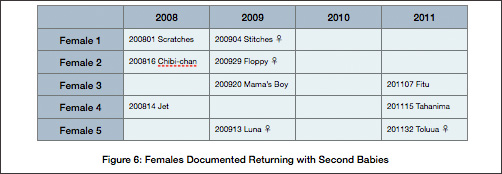
Female humpback whales that we've documented
returning to Vava'u with a second baby